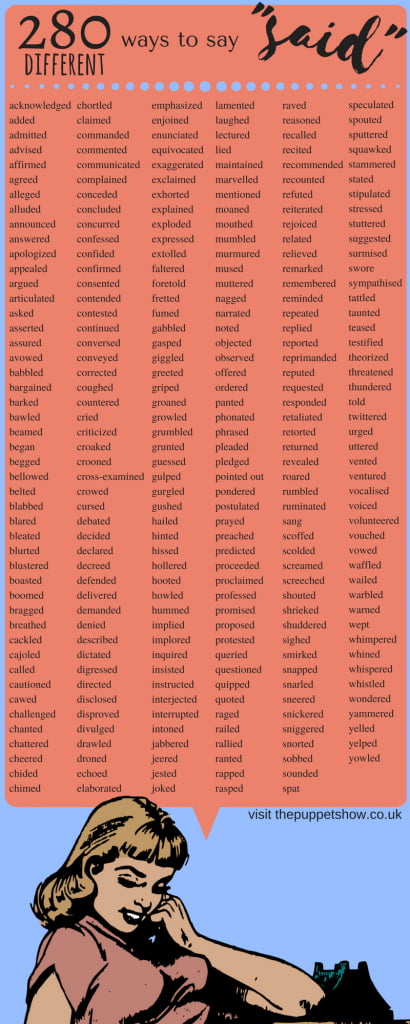If you search for alternative dialogue tags to use in your story, you’ll find many lists. While some synonyms for ‘said’ read naturally (such as words conveying volume like ‘whispered’), others come across as overwritten and forced, particularly in the wrong context.
Here are 5 simple ways to avoid clunky overuse of the common dialogue tags ‘he said/she said’ to produce compelling dialogue in your creative writing.
1. Decide if dialogue tags are necessary
Sometimes we say ‘she said’, ‘he said’ or ‘they said’ when we don’t need to. Just because it’s a writing device commonly used in dialogue doesn’t mean you have to use it. When you get to the end of a line of dialogue, ask yourself:
- Is it clear, from context, who is speaking at this moment?
- Do preceding narration and formatting (such as line breaks) help clarify who is speaking?
If you answered ‘yes’ to either of these, you don’t need tags.
For example, you wouldn’t need to use dialogue tags in the following example. The narration beforehand makes it clear who’s speaking, and the details of the characters’ speech give away who says what:
She picked a bit of fluff off her top, looked out the window. He wondered whether he was boring her.
“You seem distracted.”
“Hmm? You’re being intense again, Guy.”
It’s clear from the narration, description and actions who is saying what in the scene. The girls’ actions make it clear she’s the addressee of ‘You seem distracted.’ Her response also gives us a sense of how her date says this.
If you’re unsure about your use of dialogue tags, our novel editing services will help you make dialogue read naturally.
2. Favour unobtrusive tags
The stranger the tag, the more colorful and quirky, the more it will stick out in your dialogue. Ideally, your reader is getting as much clarity from what characters say as they get from how they say it.
Tweet This
The infographic below (via The Puppet Show) has some good alternatives. Yet it suggests words such as ‘enunciated’ as a synonym for ‘said’. However, if you were to use this tag randomly in the middle of dialogue it would seem arbitrary.
For example:
“You seem distracted,” the boy enunciated.
Because ‘to enunciate’ means ‘to say or pronounce clearly’ it doesn’t completely make sense in this context, since there isn’t a clear reason for the boy to ‘enunciate’.
However, if clarity of speech were relevant to a scene, you could use this word as a tag as it would fit. For example:
“Speak slower.” The speech therapist’s eyes were stern.
“The w-wascal wabbit wan-” he enunciated, wishing each ‘R’ could be clearer.
However, you could achieve a similar effect other ways, too. For example, using ellipses, i.e. punctuation, to show concentration; pauses:
“The w-wascal … wabbit … wan … ” He wished each R could be clearer.
This shows the effort the character is putting in, thus you don’t need a dialogue tag necessarily.
When in doubt, a simple ‘said’ is often enough. Instead of letting different ways to say ‘said’ do heavy lifting, remember this sage advice from Toni Morrison:
I never say “She says softly.” If it’s not already soft, you know, I have to leave a lot of space around it so a reader can hear it’s soft.
Make a Strong Start to your Book
Join Kickstart your Novel and get professional feedback on your first three chapters and story synopsis, plus workbooks and videos.
Learn More
3. Use physical gesture and motion instead of ‘said’
Other ways to say ‘she said’ avoid dialogue tags entirely. You may draw attention to the character who has said a line by immediately following speech with that character’s physical actions. These are also called action beats (descriptions of character action).
This is also when you can describe body language and facial expressions: the hunched shoulders, the furrowed brow, the defeated walk, the confident smile and so on.
For example:
“No I absolutely will not!” She banged the pitcher of water down on the counter so hard Sarah was surprised the bottom didn’t crack open.
“He bellowed in a deep voice and stormed through the room.”
It’s clear from just this line that a female character is in the scene with Sarah, and she’s furious.
The advantages of showing who said what via movement and gesture are:
- You can bring in scene setting elements (where the conversation is taking place and the objects surrounding characters) subtly. This adds detail and mental imagery.
- You can ground your characters’ conversations in a sense of place. This avoids dialogue that resembles heads in vats chatting away without bodies, movement or direction.
4. Use ways to say ‘said’ that add atmosphere
Using gestures and actions such as the following, as outlined above, helps to lend character and emotion to dialogue. These dialogue descriptors are useful ways of writing compelling dialogue, but go light on them. Too many of these common actions will weigh your narration down with unnecessary details. Ultimately they must serve the scene you are writing, as should all the pieces of dialogue.
- She gazed out the window (this suggests being lost in thought, or perhaps longing)
- He turned his away (suggesting withdrawal or retreat)
- They elbowed each other and jumped up and down (suggesting children vying to be heard above each other)
Also think about ways to say said that convey volume and tone, i.e. atmosphere. Although Toni Morrison’s advice above is good (creating quietness using the spaces around characters’ lines), the occasional ‘she whispered’ has its place, too.
Another example is the word ‘stated’: think how this conveys a formal tone in your writing, and see if introducing a formal tones works in your story.
Synonyms for said that show volume include:
- Quietly: ‘Mouthed’, ‘whispered’, ‘hissed’, ‘mumbled’, ‘muttered’, ‘said, under their breath’
- Loudly: ‘Yelled’, ‘shouted’, ‘bellowed’, ‘screamed’, ‘roared’
The above words remind us that tags that indicate volume and tone are typically reserved for extremes – of tension, emotion or environment. A kid protagonist might whisper in a creepy graveyard, a pranked neighbour might ‘bellow’ in pure outrage. Yet these are suitable tags for climactic moments. Make characters bellow or whisper every other line and the device loses its effect.
5. Switch to a narrator or other character’s reaction
Because dialogue is relational, an exchange between two or more characters, it also works to switch to another character’s reaction instead of focusing on the character who’s just finished speaking.
For example, read the following brief dialogue:
“You wouldn’t believe what happened next. I was-“
“John, can we pause this for a second, I really need the bathroom.”
When I returned, I couldn’t believe he was still going. Something about what not to do in an avalanche. As if he were the only one at the party who’d ever had any adventures.
Here, because the second character addresses John by name, we know who’s been speaking. Because of their interruption, as well as their shock that John is still speaking when they return, we also get a sense of how John speaks. It’s a one-way street, John holding the floor (and holding his listeners ransom).
As you can see from the above, there are many ways to show who is speaking in dialogue. Other ways to say said can avoid dialogue tags entirely. Use gesture, movement or reaction to show your reader details of character and setting.
Need help improving your dialogue? Get help with everything from formatting to context. Learn more about Now Novel’s editing services for novels.




35 replies on “421 ways to say said? Simplify dialogue instead”
Well this is getting bookmarked. I’ve attempted all of these different techniques, but have been fumbling my way through it. I’ve been compiling a list of all the different ways I’ve seen some of the best do it. This post in a way did all the heavy lifting. As always…EX-cellent stuff.
Thank you, 2Cents! I’m glad you found this helpful. Thanks for reading.
Wow! You’ve made a marvelous infographic! I couldn’t even imagine there are so many possibilities to say the word “say”, hah 🙂 And thanks for exaplaining the right usage of words. You’ve written a top-notch article!
Hi Andrew, thank you. That infographic isn’t our own creation, it says the website it is from in the image. But thank you! It’s a pleasure.
This was so helpful! I realized that there are more ways to add dialogue tags. Thanks for an amazing post once again…
Hi Niel, it’s a pleasure! Thank you for reading.
Thank you so much. This helped me from my novel.
–I exclaimed.?
I’m glad to hear that, Johnny. Good luck as you proceed with your novel.
thanks, I’m writing a novel about wolves with elemental wolves and I needed help with dialogue thank you sooooo much!
It’s a pleasure, Melis! Good luck with your supernatural story.
I’m writing a porno and this is going to be so helpful
I’m not sure how much dialogue that would involve, Amaury 🙂
Thank you! Using this for Wattpad, my username is KingKawaiiKiwi
It’s a pleasure, KingKawaii! Good luck with your Wattpad story 🙂
Thanks so much.This really helped a lot.
I’m glad to hear that, Toxic. Thanks for reading.
Nice stuff. I can’t get enough of all the tips. I write novels and I have always struggled with the tags. My readers often complain about my character interaction being “lifeless/robotic”. And sometimes even gets confused on who is saying what. So this type of post is a great help to me.
*Times to search for more posts*
That’s great to hear. Making sure your characters have clear identities, separate voices, will help too. Good luck!
Thanks the suggestion!
This is really helpful. I’m still in school, but I love to right and am working on my first novel. I’ve been having trouble elaborating on my dialogue, and this will help SOOOO much. It will make it a lot easier to not sound repetitive. Thank you for this great article!
It’s a pleasure, Lkennedy, thank you for reading our blog. I’m glad to hear you’ve found this helpful for building your dialogue. Good luck with finishing your first novel!
I’m currently writing a novel, so I’m often writing dialogue. I’ve been trying to make it sound like two characters have a great deal of trust in one another in their conversations.
(Eg. “Credit for your thoughts?” He murmured as his hands smoothed the front of my shirt. I leaned into his embrace, relaxing slightly.
“I’m just anxious to get those morons out of command and into a brig,” I nuzzled my head into Monty’s reddish hair and sighed before continuing, ” Monty, I’m honestly not quite sure what I’ll do afterwards, though.”
He paused for a moment, considering.
“You’ll figure it out, lass. After all, you’ve got trouble on your mind and evil at your feet. You’ll be fine.” I lifted my head, looking at the chron on the wall.
“Will you stay? I’m just wondering if, after we’ve dealt with the two dunces, you’ll want to stay.”
Indeed – I too have found your blog very helpful. My first story is a true one, about a family of beloved animals we have had the pleasure of living with. It didn’t seem too challenging writing the first two words. ‘Chapter One.’
After that it all, well – went downhill. Thankfully, I’ve completed the book – somehow! Now of course it is the unenviable task (read chore) of proofing it. Not surprisingly I’ve come across grammatical errors a plenty.
As I progressed through the proofing, ‘I said’ / ‘I thought’ d-tags were cropping up WAYYYY too frequently.
My hat is suitably doffed. Thank you.
A book about animals sounds great to me, Archie (My Family and Other Animals came to mind). I’m glad to hear you’ve finished your book and that our article was helpful. If you’re thinking of getting an editor’s insights, we offer a range of editing services. Good luck with the next phase in your project.
Saying, what are you smoking? I want some, a positive phrase. I think it is. Another thinks it is not.
This will help so much ! I’m still in High-School but I’m aiming to start young ,my writing is a little wacky but this helped SO much ! ;I’m glad I found something like this!
That’s fantastic, Estefan – you’re never too young to start! Wacky writing is the best, just look at how popular writers such as Douglas Adams, Roald Dahl or Lemony Snicket are. Good luck with it.
I love this list and the writing tips as well. Thank you so much.
Thank you for your kind feedback, Joan. I’m glad you enjoyed this article. It’s a pleasure! Thanks for reading our blog.
This is really helpful! I’m writing a novel, or trying to at least. Thanks for this wonderful tool! 😀
It’s a pleasure, ES. Thank you for sharing your feedback. Good luck with your novel!
Thank you so much! I am in Middle school still but I’ve started writing a dystopian/fantasy novel and these definitely helped me out with my dialogue!
Hi JJ, I’m so glad to hear that. That sounds a fun genre mix, good luck with your novel!
Thank you very much for this blog! I’m working on a story at the moment and I always use this when I work on it.
Hi Kenneth, I’m glad to hear that. It’s a pleasure. What’s your story about? Good luck with it.